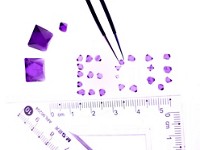Advertisement
Grab your lab coat. Let's get started
Welcome!
Welcome!
Create an account below to get 6 C&EN articles per month, receive newsletters and more - all free.
It seems this is your first time logging in online. Please enter the following information to continue.
As an ACS member you automatically get access to this site. All we need is few more details to create your reading experience.
Not you? Sign in with a different account.
Not you? Sign in with a different account.
ERROR 1
ERROR 1
ERROR 2
ERROR 2
ERROR 2
ERROR 2
ERROR 2
Password and Confirm password must match.
If you have an ACS member number, please enter it here so we can link this account to your membership. (optional)
ERROR 2
ACS values your privacy. By submitting your information, you are gaining access to C&EN and subscribing to our weekly newsletter. We use the information you provide to make your reading experience better, and we will never sell your data to third party members.

This crystal of silicon carbide (SiC) is almost as hard as diamond. In fact, moissanite, which is another name for SiC, is used as a less expensive alternative to diamonds in jewelry. Because of its hardness, SiC also is used in bulletproof vests and is added to products to provide textured surfaces that won’t wear out, like the grip tape on skateboards. Scientists first discovered SiC in a meteorite in 1893—naturally occurring SiC is extremely rare on Earth. Since then, the vast majority of SiC has been made in the lab. Tokyo Institute of Technology’s Kouichi Yasuda made this 10-cm-tall crystal by applying a direct electric current to a mixture of silicon dioxide and carbon powders.
Submitted by Yoko Taka
Do science. Take pictures. Win money. Enter our photo contest here.
For more Chemistry in Pictures, visit our new home on cen.acs.org.





Join the conversation
Contact the reporter
Submit a Letter to the Editor for publication
Engage with us on Twitter